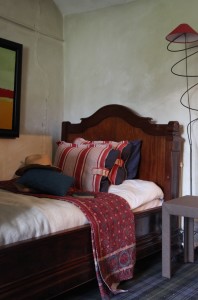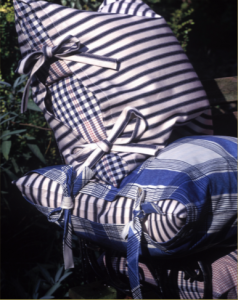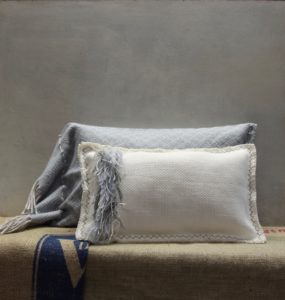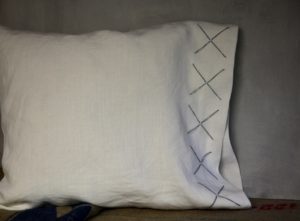Image from Calluna: Cushions – Heather Luke
Hemp striped shams with Mulberry leather buckle ties
In it’s most used form a sham is a secondary and protective cover for a cushion, that may or may not be the same size. Often it’s smaller, tied at one or both sides. These are used for stool, garden, settle and chair seats, for cushions where the fabric beneath is delicate or difficult to launder, and for bedheads. The only criteria is that the sham cover material must be more robust than the one it’s covering ….. so we choose washable and hardwearing.
Dependent on the location and use a sham can be made of sheeting, ticking, gingham, denim, pique and any worn fabric item that has some good material left in it – linen sheets for example, where the sides are still good after the centre has worn. Any of the traditional sitched and quilted techniques and patchworks, such as boro, kantha, sashiko and patchwork by pattern is not only suitable but provides authentic solution, the right solution, to the problem.
And in the garden…
Decorative shams also fall into another category. These are designed to look very pretty as a means to cover up, disguise the plainer bed pillows. In this case the covers are made to look as beautiful in terms of finish and decoration as possible.
Often very feminine, as a frilled cover that slips over a pillow for an elegant and welcoming daytime look. When the bed is true back the cover is popped into a chest or cupboard over- night or whenever it’s not needed. We tend to make these for the guest bedrooms of very well furnished homes, usually where there is plenty of help and storage. Although having said that, the most pertinent point is that these represent the way a homeowner wants to welcome a guest, and even with no help pretty pillows shams can be very high on the list of must-haves.
Image from Calluna: Cushions – Heather Luke
An antique pillow cover from Grannies line cupboard made into a ‘sham’ – to be removed when the pillow beneath is used for sleeping.
Having pillow shams as opposed to spare pillows is open to debate, both are removed from the end so in the end it’s just personal choice.
On the whole it’s better to keep the main beds as straightforward as possible, leaving such indulgences to guest rooms with occasional use.
All embroidery and decorative techniques and finishes, antique laces and vintage materials are especially suited to pillow shams, as these are supposed to be pretty, feminine and romantic. There’s nothing wrong with making a tweed or more masculine pillow sham, but men aren’t really smitten by cushions, however well made, and in fact mostly tend to be irritated by them.
Image from Calluna: Cushions – Heather Luke






